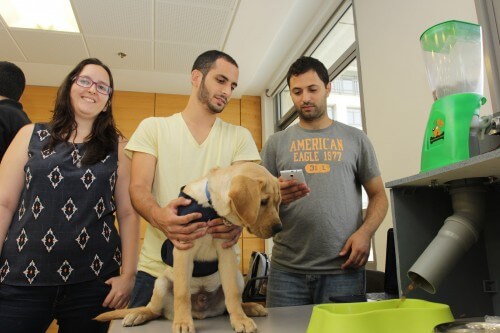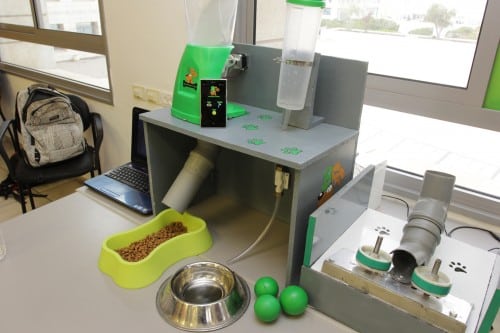Three students from the Faculty of Computer Science at the Technion developed a smartphone-controlled system that takes care of the dog in the absence of the owner. The young guide dog Luke is the source of inspiration and the main experimenter

Maoz Elbaz, Nir Cohen and Shir Zviel are three students from the northern region, who met and became friends during their studies in the Faculty of Computer Science at the Technion. About six months ago, they decided to do the final project together in the course for programming systems in the Arduino environment, under the guidance of Professor Yossi Gil and with the help of experts from Microsoft, and began to think about a topic.
Fortunately, shortly before that, Mauz adopted a labrador puppy named Luke. Luke, who was "loaned" to Ma'oz by the "Israeli Center for Guide Dogs" association at Beit Oved, came to him as a six-week-old puppy for training and training. Today, there are many such puppies roaming the Technion campus, attached to the students 24 hours a day - also in classes and in the library - completely volunteered by the students. After this period, the puppies are returned to the association, for further training, before being handed over to their blind owners.
Maoz, who works at the Medisafe company at the same time as his studies, spends many hours outside his home. "Nowadays Luke comes everywhere with me, but it is clear to me that this is not the case with most dogs. Working people have to leave the dog at home, sometimes for eight to ten hours a day. They know it's not ideal, but they have no choice. We thought how we could help them. That's why we wanted to develop an app that would allow them to take care of the dog with the push of a button."

"We thought about the basic things a dog needs," says Nir Cohen, who works at Intel while studying. "First of all - water and food, and then some activity. Dogs need to receive measured amounts of food in a certain dose and at fixed times, and in some cases precise regulation of the water is also required. Our system does all this, and also prevents the water and food from staying in the open feeders for a long time."
In the final project, the three were required to use an Arduino - a controller to which sensors and motors are connected, which operate according to a code written in advance and burned into the controller itself. "There was a lot of work here," says Nir. "Besides the programming itself, which is required for each sub-system separately, we faced mechanical challenges related to opening the feeding system (based on a cornflakes device), regulating the water and shooting the balls - the chosen game activity. In addition, we waited almost two months until the special motors for throwing the ball arrived from abroad."
"It was really not a simple project," says Shir Zviyal. "And there were many unexpected malfunctions, such as a motor that failed to turn the cornflex tap. But at this stage in our studies, nothing deterred us anymore. Because that's what's beautiful about the Technion: you lose the fear of challenges. The Technion teaches you to learn on your own and more than that - to believe that you will know how to overcome any problem."
Indeed, they overcame all the problems, and today they present a successful initial prototype, which opens the cornflex faucet using an array of gears. The system stands up well to the weight of playful Luke, who is no longer a small puppy. "Part of the work is to get the dog used to the system," Maoz explains. "He needs to understand that for the game to work he needs to return the ball to the tube, and that in order to eat fresh food he needs to approach the device as soon as he hears the food fall."
Since it is a technology-focused project, they did not conduct a comprehensive market survey, but from conversations with dog owners, they got the impression that there is marketing potential for their invention. "We have many ideas for the continuation," says Shir. "For example, documenting the system's activity on the cloud, automatically ordering food when the bag runs out, and various features such as automatic electric opening of the house door when the dog wants to go out for needs. But right now we are too busy with work and studies."
Soon they will finish their studies, and when they summarize the period it is difficult to find a word of negative criticism. "It's a great time," say all three. "Studies at the Technion are of a very high standard and there is also an excellent social life. We have a very close-knit group here that studies together and hangs out together. All in all, it was a really good period, with a lot of development at the social level and on the social level, and this project was definitely one of the highlights."
More on the subject on the science website
What is allowed to be given to dogs to eat and what is not allowed
